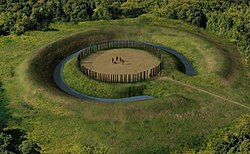 Artists conception of Mount Horeb Site 1 | |
| Location | Lexington, Kentucky, Fayette County, Kentucky, US |
|---|---|
| Region | Fayette County, Kentucky |
| Coordinates | 38°9′32″N84°27′56″W / 38.15889°N 84.46556°W |
| History | |
| Cultures | Adena culture |
| Site notes | |
| Excavation dates | 1939 |
| Archaeologists | William S. Webb |
| Architecture | |
| Architectural styles | Earthworks, causewayed ring ditch, timber circle |
The Mount Horeb Earthworks Complex is an Adena culture group of earthworks in Lexington, Kentucky. It consists of two major components, the Mount Horeb Site 1 and the Peter Village enclosure, and several smaller features including the Grimes Village site, Tarleton Mound, and Fisher Mound. [1] The Peter Village and Grimes Village enclosures were mapped by Rafinesque and featured in Squier and Davis's landmark publication Ancient Monuments of the Mississippi Valley in 1848 as Plate XIV Figures 3 and 4. [2]







